#FlutterWeb
Explore tagged Tumblr posts
Text
Thinking about building a web application that performs like a native app?
Progressive Web Apps (PWAs) are the future—and when combined with Flutter, they become even more powerful.
At Rlogical Techsoft, we’ve created an in-depth guide that walks you through how to develop and launch a full-featured PWA using Flutter, making it easier than ever to deliver a fast, reliable, and engaging user experience across platforms.
Why Flutter for PWA Development? Flutter offers a single codebase, hot reload, beautiful UI components, and excellent web support, making it a smart choice for PWA development. Whether you’re targeting Android, iOS, or the web, Flutter helps you build consistent, responsive apps quickly.
🚀 What You’ll Learn in the Blog: ✅ Key benefits of using Flutter for PWAs ✅ Setting up your development environment ✅ Structuring your Flutter PWA project the right way ✅ Tips for optimizing performance and responsiveness ✅ How to deploy your PWA using Firebase Hosting ✅ Ensuring cross-browser compatibility and installability
📈 PWAs provide an app-like experience without the need for app store downloads, resulting in higher user engagement and broader accessibility—ideal for startups, businesses, and enterprises alike.
🔗 Read the full guide here:
https://www.rlogical.com/blovg/develop-and-launch-progressive-web-app-with-flutter/
Embrace the next wave of digital transformation. Whether you’re a developer, product owner, or tech decision-maker, now is the time to explore Flutter-powered PWAs.

#PWADesign#PWATech#AppDevelopment#WebApps#CrossPlatform#FlutterWeb#FirebaseHosting#MobileFirst#TechInnovation#StartupTech#WebDevelopment#UserExperience#DigitalTransformation#FrontendDevelopment#SoftwareEngineering#MobileDevelopment#FlutterDev#PWASolutions#Rlogical#FlutterCommunity
0 notes
Text
Is Flutter the Right Choice for Web Development?

Are you curious about whether Flutter is suitable for web development? Explore how Flutter enables developers to create high-performance, visually appealing web applications using a single codebase. This article delves into the benefits and challenges of utilizing Flutter for web projects, helping you determine if it's the right choice for your development needs.
#flutter#webdevelopment#flutterweb#crossplatform#appdevelopment#techstack#webapps#frontenddevelopment#uiux#softwaredevelopment#flutterdev#mobiletoweb#coding#techtrends#webperformance#flutterforweb#hireflutterdev
0 notes
Text
Optimizing Flutter Apps for Performance with Impeller

Users expect applications to deliver a flawless and responsive experience. Flutter, a popular open-source framework for building beautiful cross-platform apps, empowers developers with rich UI capabilities and a productive development workflow. However, as app complexity grows, ensuring optimal performance becomes crucial.
Impeller tackles the challenge of performance optimization head-on. By leveraging modern rendering techniques and precompiled shaders, it significantly improves frame rates and reduces jank, leading to smoother animations and a more delightful user experience. This article delves into the inner workings of Impeller, explores its benefits for developers, and provides a practical guide for integrating it into your Flutter projects.
Understanding Impeller
Impeller operates under the hood to streamline the rendering process in Flutter apps. Let's explore some of the core functionalities that contribute to its performance improvements:
1. Precompiled Shaders
Traditional rendering engines often compile shaders (programs executed on the GPU) at runtime. This compilation process can introduce a slight stutter in the UI, especially on initial app launch. Impeller tackles this by precompiling all necessary shaders during the engine build phase. This eliminates shader compilation jank, ensuring a smooth and seamless user experience from the very first interaction.
2. Modern Graphics APIs
Impeller ditches the generic rendering approach and instead takes advantage of device-specific graphics APIs like Metal (iOS) and Vulkan (Android). These APIs offer fine-grained control over the GPU, allowing Impeller to optimize rendering tasks for each platform. This targeted approach leads to more efficient resource utilization and ultimately, smoother rendering.
3. Concurrency Management
Flutter applications rely heavily on animations and complex UI transitions. Impeller addresses this by employing a multi-threaded rendering approach. It distributes rendering workloads across multiple CPU cores, enabling parallel processing of graphics tasks. This concurrency significantly improves frame rates and reduces dropped frames, resulting in a more responsive and visually appealing app.
4. Code Portability
A key advantage of Impeller is its focus on abstraction. While it utilizes platform-specific graphics APIs under the hood, Impeller exposes a unified API to developers. This means your code remains portable across different platforms, future-proofing your development process and reducing the maintenance burden.
Benefits of Using Impeller
Integrating Impeller into your Flutter project unlocks a range of performance enhancements that elevate the user experience of your app. Let's explore some of the key benefits:

1. Improved Frame Rates and Reduced Jank
By eliminating shader compilation overhead and leveraging efficient multi-threaded rendering, Impeller delivers significantly smoother animations and UI interactions. This translates to a more enjoyable user experience, free from dropped frames and stuttering animations. Imagine a buttery-smooth scrolling experience in your next social media app – that's the power of Impeller!
2. Enhanced Rendering Performance
Impeller's utilization of modern graphics APIs like Metal and Vulkan allows for more efficient resource allocation on the GPU. This translates to faster rendering times and a reduction in overall power consumption. This benefit is particularly crucial for graphics-intensive applications like games or augmented reality experiences.
3. Reduced Development Friction
Precompiled shaders streamline the development process. Developers no longer need to worry about runtime shader compilation errors or unexpected performance bottlenecks. This allows for faster development cycles and a more focused approach on crafting engaging user experiences.
4. Cross-Platform Consistency
A significant advantage of Impeller's abstraction layer is its ability to deliver consistent performance gains across different platforms. Whether you're targeting iOS or Android, Impeller ensures a smooth and responsive user experience, eliminating the need for platform-specific performance optimizations.
Integrating Impeller into Your Flutter App
Embracing the performance benefits of Impeller requires minimal effort from developers. Here's a breakdown of the steps involved:
Prerequisites
Before diving into the integration process, let's ensure you have the necessary prerequisites in place:
Flutter Version: Impeller is a relatively new addition to the Flutter ecosystem. To leverage its features, you'll need to be using a Flutter version that officially supports it. As of this writing, stable support for Impeller is available starting with Flutter version 3.10. You can check your current Flutter version by running flutter --version in your terminal.
Development Tools: Ensure you have a compatible development environment set up for your target platform (iOS or Android). This includes the relevant SDKs (iOS SDK, Android SDK) and development tools (Xcode for iOS, Android Studio for Android).
Project Setup: It's recommended to start with a clean Flutter project when integrating Impeller for the first time. This ensures a smooth integration process and avoids potential conflicts with existing project configurations. You can create a new Flutter project using the flutter create command in your terminal.
Enabling Impeller
Once you've confirmed the prerequisites, enabling Impeller in your Flutter project is a straightforward process. Here's how to do it:

1. Activating Impeller During Development (Android & iOS):
There are two main approaches to enable Impeller depending on your development stage:
Using the flutter run command:
For both Android and iOS development, you can activate Impeller during the development phase using a flag with the flutter run command. Simply add the --enable-impeller flag after the command:
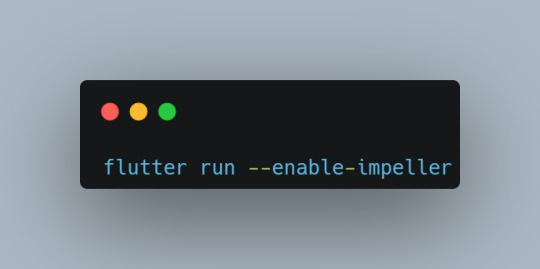
This will instruct Flutter to use the Impeller rendering engine during your development session.
Enabling Impeller in your Flutter Code (Android Only):
For Android development specifically, you can also enable Impeller programmatically within your Flutter code. This approach offers more granular control over Impeller usage. Here's an example snippet demonstrating how to enable Impeller:
Code snippet
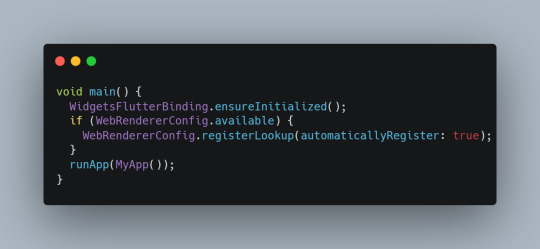
In this example, we're checking for the availability of the WebRendererConfig class, which indicates Impeller support. If available, we register the lookup function to enable Impeller.
Important Note: Enabling Impeller programmatically within your code is currently not supported for iOS development.
2. Disabling Impeller (Optional):
While Impeller offers significant performance benefits, there might be situations where you want to temporarily disable it for debugging purposes or compatibility testing. Here's how to do it:
Using the flutter run command:
Similar to enabling Impeller, you can use a flag with the flutter run command to disable it:
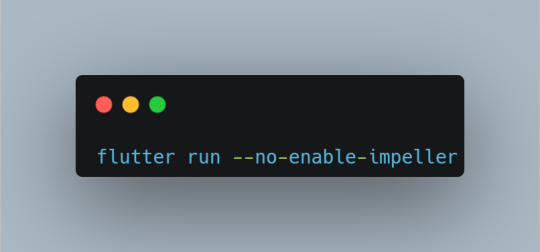
This will instruct Flutter to use the default Skia rendering engine during your development session.
Disabling Impeller in your Flutter Code (Android Only):
For Android development, you can disable Impeller programmatically by simply removing the WebRendererConfig.registerLookup call from your code.
3. Enabling Impeller for Release Builds (Android & iOS):
While enabling Impeller during development is straightforward, integrating it for production builds requires additional configuration. The specific steps might differ slightly depending on your target platform:
Android: For Android releases, you'll need to modify your app's AndroidManifest.xml file. Add the following meta-data tag under the tag:
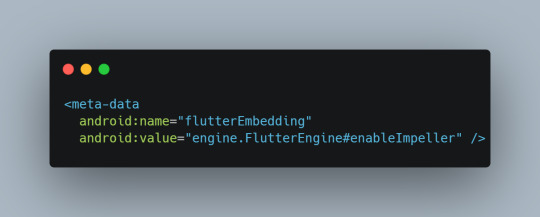
iOS: For iOS releases, you can enable Impeller by adding a new key under the top-level dictionary in your app's Info.plist file:
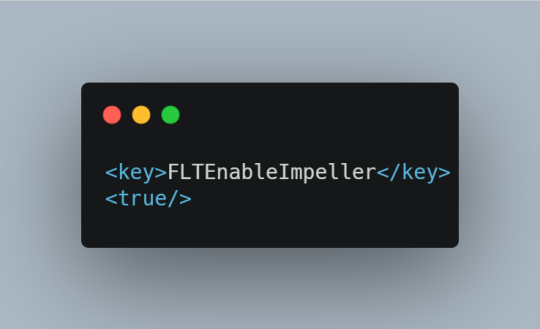
Remember, these are just general guidelines. It's recommended to refer to the official Flutter documentation for the most up-to-date instructions on enabling Impeller for release builds.
Considerations and Best Practices
While Impeller offers a compelling path to performance optimization, it's essential to consider some factors and best practices for successful integration:
Limited Platform Support Currently, Impeller is still under active development and has stable support only for Android and iOS platforms. Web support for Impeller is yet to be officially released. Keep this in mind when targeting other platforms like web or desktop with Flutter.
Experimental Features: Certain functionalities within Impeller might be marked as experimental. While these features can offer additional performance benefits, they might be subject to change or removal in future Flutter releases. Use experimental features with caution and thoroughly test your app before deploying it to production.
Profiling and Monitoring: Even with Impeller enabled, it's crucial to continuously profile and monitor your app's performance. Tools like the Flutter DevTools Performance View can help identify performance bottlenecks and ensure your app delivers a consistently smooth experience.
Community Resources: The Flutter community is a valuable resource for learning and troubleshooting Impeller-related issues. Utilize forums and online communities to connect with other developers and stay updated on the latest Impeller developments.
By following these considerations and best practices, you can effectively leverage Impeller to create high-performance Flutter applications that provide a delightful user experience.
Profiling Performance with Impeller
Now that you've integrated Impeller, let's explore techniques to analyze its impact on your app's performance.
Flutter DevTools and Performance View
Flutter DevTools is an essential suite of tools for debugging and profiling Flutter applications. Within DevTools, the Performance View provides valuable insights into your app's rendering performance.
Here's how to leverage DevTools for profiling with Impeller:
Connect to your Running App: Ensure your Flutter app is running on a connected device or emulator. Open DevTools in your IDE or use the flutter run --dart-dev-tools command to launch it separately.
Navigate to the Performance View: Locate the Performance View within DevTools. This view displays a timeline chart depicting various activities happening within your app, including frame rendering times.
Analyze Frame Times: With Impeller enabled, you should observe a smoother frame rendering pattern in the timeline chart. Look for reduced spikes and a more consistent frame rate compared to using the Skia rendering engine.
Identify Bottlenecks: Even with Impeller, there might be occasional performance hiccups. Use the Performance View to identify specific frames that take longer to render. Investigate the corresponding code sections and optimize them for better performance.
Key Metrics to Track
While the Performance View provides a visual representation, it's helpful to focus on specific metrics:
Frame Times: This metric indicates the time it takes for your app to render a single frame. Aim for consistent frame times around 16 milliseconds for a smooth 60fps experience.
Dropped Frames: A dropped frame occurs when your app fails to render a frame within the allotted time. A higher number of dropped frames indicates performance issues.
Memory Usage: Monitor your app's memory consumption. While Impeller can improve rendering performance, it might introduce slight memory overhead in some cases.
By continuously monitoring these metrics and utilizing the Performance View, you can ensure that Impeller is effectively optimizing your app's performance.
Conclusion
Impeller emerges as a powerful tool in the Flutter developer's arsenal for crafting high-performance apps. By leveraging precompiled shaders, modern graphics APIs, and efficient concurrency management, Impeller delivers significant improvements in frame rates and reduces jank, leading to a more responsive and visually appealing user experience. Integrating Impeller is a straightforward process, and the benefits extend across both development and production environments.
However, it's important to remember that Impeller is still under active development, with limited platform support and some experimental features. Careful consideration and adherence to best practices are crucial for successful integration. Utilize profiling tools like the Flutter DevTools Performance View to continuously monitor your app's performance and ensure Impeller is delivering its full potential.
The future of Impeller is bright. As the technology matures and receives broader platform support, it has the potential to become the go-to rendering engine for high-performance Flutter applications. We encourage you to experiment with Impeller, stay updated on the latest developments, and contribute to the vibrant Flutter community!
#coding#artificial intelligence#programming#flutter app development#app development#flutterweb#impeller
0 notes
Text

👉 Code Your Dreams into Reality! 💻💡
Your Future with Our Flutter App Development Course! 📱✨
Ready to dive into the world of mobile app development? Join us at Mewar University and gain the skills to create stunning apps using Flutter!
🚀 Whether you're an IT student or a graduate from any field, our course is designed for YOU!
🔍 What You'll Learn: ✅️ Fundamentals of Flutter ✅️ Building beautiful UIs ✅️ Integrating APIs & much more!
📅 Don't miss out this incredible opportunity to advance your academic career and make significant contributions to your field.
#AdmissionOpen #MewarUniversity #TopUniversityInRajasthan #KnowledgeToWisdom #BestUniversityInRajasthan #Flutter #AppDevelopment #MobileApps #Coding #TechSkills #SoftwareTraining #ITCourses #mobileapp #ui #fluttercode #flutterprogrammer #fluttercommunity #fluttermafia #flutterapplication #mobileapplication #systemdesign #designpattern #flutterweb #dart #flutterappdeveloper #fluttertutorial #flutterapplication #flutterdevs
1 note
·
View note
Text
Happy Maha Shivratri

#appdevelopment#flutter#flutterdeveloper#centurustechnologies#centurus#appdeveloper#webdevelopment#webdesign#flutterweb#dart#shivratri#mahashivratri#shiv#mahadev
0 notes
Video
tumblr
Google Sign in Flutter Web
0 notes
Link
#flutter#flutterapp#appdev#mobileapp#flutterweb#flutterui#appdevelopment#flutterdev#flutterAppDevelopment#android#ui#ux#appdesign#flutterapps
0 notes
Link
What is Flutter? Should I Choose Flutter for Mobile App Development, Read here a full blog about flutter benefits & decide what technology you want to choose for your app development project.
#Flutter_Benefits
•Solo codebase •Dart as a programming language •Usage of customizable widgets •Provide Native themes for iOS/Android •Stateful hot reload •Countless packages and wide-ranging community •Strong design experience •Supports a variety of IDEs •Cool animations •Create apps for mobile, desktop and the web
More Details: https://www.xceltec.com/should-i-choose-flutter-for-mobile-app-development/
#what is flutter#XcelTec#flutterdevelopmentservices#flutterandroid#flutterdeveloper#flutterweb#flutterwebapp#flutterwebproject#flutterforwebdevelopers#flutterforandroiddevelopers#flutterformobileappdevelopment#flutterformobiledevelopment#flutterformobileandweb#flutterformobileapps#fluttermobileframework#flutterbenefits#fluttertechnology
0 notes
Photo
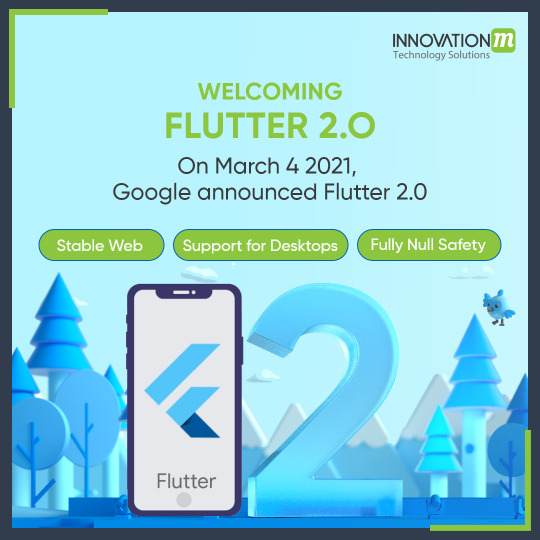
What's better than getting the new version of your best support? That's right, it's Flutter 2.0! Announced by Google this 4th of march 2021. With better stability, desktop support, and a lot more!
https://www.innovationm.com/web-design-and-development-company
https://www.innovationm.com/android-app-development
0 notes
Link
😀 100% Off 😀 🔰 Flutter Web Development Course Build Complete FlutterWeb App – 100% Free 🔰 🙏 Enroll ASAP #Development #WebDevelopment #DartProgrammingLanguage #udemycoupon #freeudemycourses #udemy #freecourses #techbachat https://techbachat.in/udemy-coupon/flutter-web-development-course-build-complete-flutterweb-app-100-free/
0 notes
Photo

Flutter Web - Building a Responsive Website in Flutter | Flutter Tutorial http://ehelpdesk.tk/wp-content/uploads/2020/02/logo-header.png [ad_1] flutterweb #flutterforweb #flutt... #androiddevelopment #angular #c #css #dataanalysis #datascience #deeplearning #development #docker #flutter #flutterappdevelopment #flutterapptutorial #flutterforweb #flutterforwebdevelopment #flutterforwebtutorial #flutterresponsivedesign #flutterresponsiveui #fluttersdk #fluttertutorial #fluttertutorialforbeginners #fluttertutorialvscode #flutterui #flutteruidesign #flutterweb #flutterwebapp #flutterwebdevelopment #flutterwebtutorial #googleflutter #googlefluttertutorial #iosdevelopment #java #javascript #machinelearning #node.js #python #react #unity #webdevelopment
0 notes
Photo

https://tech.siteworld.in/ Flutter Web Development Course Build Complete FlutterWeb App https://tech.siteworld.in/flutter-web-development-course-build-complete-flutterweb-app/ Get More Free Udemy Courses https://tech.siteworld.in/free-udemy-courses/ https://www.instagram.com/p/B6QVzxYhMdX/?igshid=18unppeqrvyb1
0 notes
Text
Happy Lohri !!!!!!!!!!!!!!

#appdevelopment#flutter#flutterdeveloper#centurustechnologies#centurus#appdeveloper#webdevelopment#webdesign#flutterweb#dart#lohri#happylohri
0 notes
Photo

Flutter Web Development Course Build Complete FlutterWeb App https://ift.tt/2M29qtH
0 notes
Photo

😜 just solved the #flutterPuzzleHack!! in 933 moves 😅 #flutter #flutterdeveloper #flutterhack #puzzlechallenge #puzzlehack #flutterweb #flutterchallenge https://www.instagram.com/vijaycreations_for_flutter/p/CY9zA3LhPYh/?utm_medium=tumblr
#flutterpuzzlehack#flutter#flutterdeveloper#flutterhack#puzzlechallenge#puzzlehack#flutterweb#flutterchallenge
0 notes
